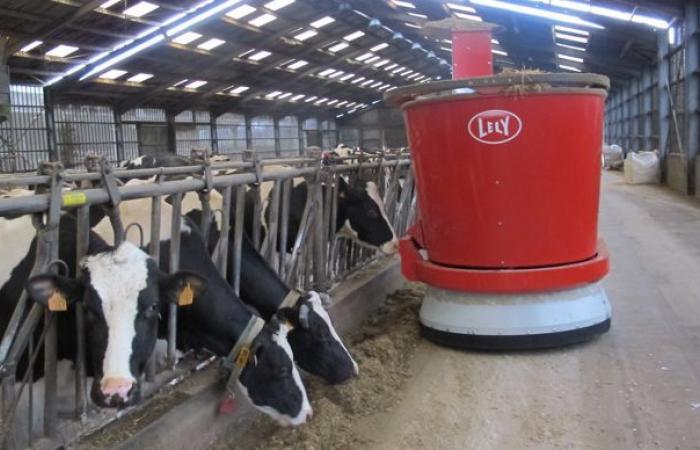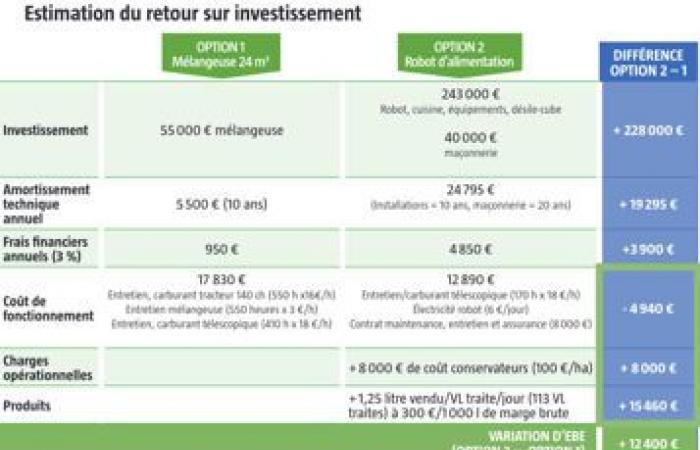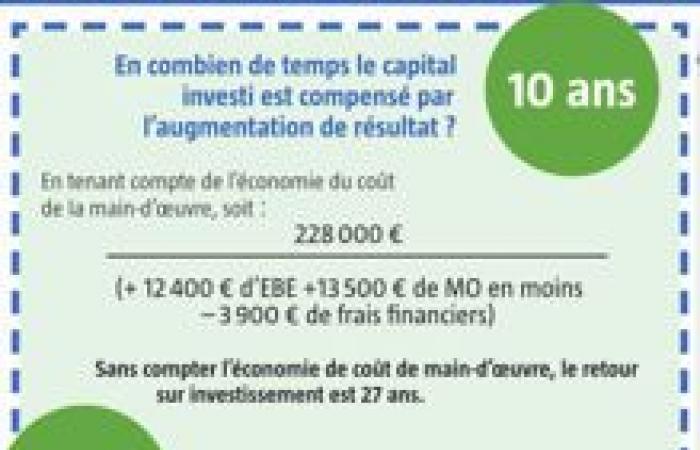After milking, it is the turn of the feed distribution to become automated. Breeders are primarily interested in it to reduce the on-call time and the arduousness of this task. With the expansion of dairy structures, the number of batches of animals and rations to manage has multiplied (dairy cows, dry cows, calving prep, heifers, fattening animals, etc.). On average, on a herd of 73 milked cows, the time dedicated to feeding is around two hours per day, half of which is dedicated to groups of animals other than the milked cows (source: Inosys Bretagne survey, 2019).
Beyond the organization of work, feeding robots are also attractive for the improvement in milk performance that they can induce. With a regular, fresh ration all day long, in certain situations we observe productivity gains per cow greater than 1.5 kg/VL/day. A milk response which will vary greatly depending on the initial situation of the farm.
With an installation cost ranging from €200,000 to €300,000 for a bowl with associated equipment, it is essential to measure the impact on the system and the return on investment of such a project.
THE INITIAL SITUATION Gaec Desiles is a specialized dairy farm of 130 VL producing 1,225,000 liters. Cows are fed in two complete rations depending on the stage of lactation. Currently equipped with a telehandler and an 18 m mixer3 too small, the breeders spend around two hours and fifteen minutes preparing, distributing and pushing back the rations for all the batches of animals. A situation that does not suit them because they want to reduce this on-call time. They then assess the economic interest of installing a feeding robot. LA SIMULATION Maël Raulo’s comment “Productivity gains, under conditions”Manufacturers announce a gain in milk productivity of around 1.5 kg/VL/day. However, it depends on the starting situation! On many farms, we observe that the ration is not accessible 24 hours a day by the animals. This lack of availability at the trough is glaring at night when the ration is sometimes completely unavailable between 2 a.m. and 7 a.m., or 20% of the day! When the animals are fed freely 24 hours a day and competition at the trough is limited, the productivity gain allowed by the feeding robot is low, or almost zero.
The real time saving is in “small batches” (example: heifers or specific rations dry up). In fact, the small volume of the bowl promotes a more homogeneous mixture than in a mixer and makes it possible to distribute a “fresh” ration daily, thus limiting the sorting phenomenon. The longer the “dead” times of the device (movement, mixing time, presentation of the fiber), the more the tonnage distributed daily will be reduced, at the risk of having undernourished animals. We will therefore be vigilant regarding the sizing of the machine in relation to the breeding context.
THE ANALYSIS Aubin Lebrun’s comment “Properly quantify the investment and the evolution of costs”“For Gaec Desiles, we can estimate a return after ten years, i.e. the approximate lifespan of the machine.
These thermal robots, in almost continuous operation, require significant consumption of GNR. »
Depending on the breeding context and the ease of integration of the robot and the kitchen, the amount of investment may vary considerably. We will be careful to properly quantify the ancillary equipment (silos, sile-cube, options, etc.) linked to the project. More complicated but essential, it will be necessary to evaluate the evolution of loads and products with the automaton. For example, the use of fodder preservatives is strongly recommended in order to limit losses through oxidation.
Depending on the products used, this can represent a cost of more than €100/ha. We also observe significant differences in maintenance costs depending on the manufacturer. Infrastructure-free and fully autonomous feeding robot systems also exist on the market.
The current layout of the farm would allow the installation of a feeding robot. The silos are stabilized (coated floor and concrete walls). A storage building near the stables and silos could be used to set up the kitchen and the robot’s charging place. In this situation, the investment would amount to €283,000.
An amount to be compared to that of replacing the current mixer which must be renewed because it is too small. For a 24 m mixer3 new, the investment would amount to €50,000-60,000.
THE CONCLUSION “Variable profitability depending on the number of animals to be fed” “Food automation is a solution for reducing on-call time, but the return on investment should be measured before taking the plunge. This will be very dependent on the capital invested and the savings in structural costs (mechanization, GNR, employees) obtained thanks to the automation. The return on investment will be even faster as the number of animals and batches to manage is significant. It is for this reason that these machines are particularly popular on large dairy farms, sometimes with a beef cattle workshop in addition. Before considering a feeding robot, it is necessary to evaluate the interest of more modest investments (fodder pusher robot, silos with auger, silos with load cells, unique mineral on the menu) which can also improve the conditions and the working time. »








